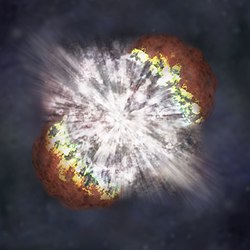- This diagram illustrates the pair-instability process that astronomers think triggered the explosion in SN 2006gy. A sufficiently massive star can produce gamma rays of such high energy that some of the photons convert into pairs of electrons and positrons causing a runaway reaction which destroys the star.
- SN2006gy (top right) in infrared
- SN2006gy (top right) in ultraviolet
- NASA artist's impression of the explosion of SN 2006gy
 SN 2006gy and the core of its home galaxy, NGC 1260, viewed in x-ray light from the Chandra X-ray Observatory. The NGC 1260 galactic core is on the lower left and SN 2006gy is on the upper right. | |
| Event type | Hypernova |
|---|---|
| IIn [1] | |
| Date | c. 238 million years ago (discovered 18 September 2006 by Robert Quimby and P. Mondol) |
| Constellation | Perseus |
| Right ascension | 03h 17m 27.10s [2] |
| Declination | +41° 24′ 19.50″ [2] |
| Epoch | J2000 |
| Galactic coordinates | 150.2568 -13.5916 |
| Distance | c. 238 million ly [3] |
| Host | NGC 1260 |
| Progenitor | Hypergiant |
| Notable features | is located 2.0" W and 0.4" N of the center of NGC 1260 |
| Peak apparent magnitude | +14.2 |
| Other designations | SN 2006gy |
| | |
SN 2006gy was an extremely energetic supernova, also referred to as a hypernova, [4] that was discovered on September 18, 2006. It was first observed by Robert Quimby and P. Mondol, [2] [5] and then studied by several teams of astronomers using facilities that included the Chandra, Lick, and Keck Observatories. [6] [7] In May 2007, NASA and several of the astronomers announced the first detailed analyses of the supernova, describing it as the "brightest stellar explosion ever recorded". [8] In October 2007, Quimby announced that SN 2005ap had broken SN 2006gy's record as the brightest-ever recorded supernova, and several subsequent discoveries are brighter still. [9] [10] Time magazine listed the discovery of SN 2006gy as third in its Top 10 Scientific Discoveries for 2007. [11]




